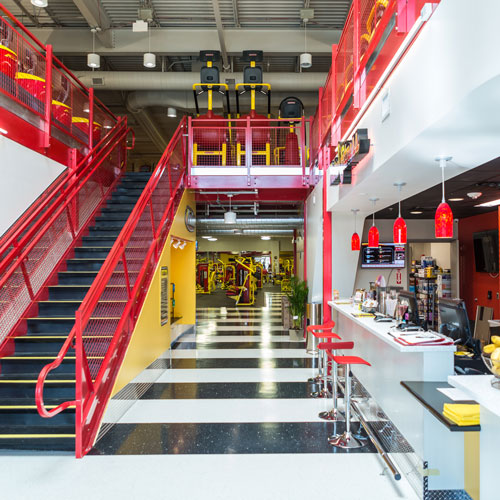When Dan Adelstein joined Orangetheory Fitness in 2012, he came aboard as a coordinator to help cofounder and CEO Dave Long. It was still a relatively new brand, with 15 studios open in Florida. Adelstein had recently finished as the senior vice president at the Growing Room and was looking for a less hectic schedule. It was a welcome surprise, however, that over the next three years, Orangetheory grew tremendously. Now, the company has more than 200 studios around the world, and just recently it announced three new store openings in Australia.

—Dan Adelstein, Director of Real Estate and Franchise Development
As the director of real estate and franchise development, Adelstein is instrumental in negotiating locations for Orangetheory Fitness’s studios. The brand has proved tremendously popular, which is a boon for Adelstein and his team. According to Adelstein, Orangetheory is “unique from most everything out there.” That unique fitness offering has garnered worldwide attention, and the momentum shows no signs of quitting anytime soon.
The Orangetheory Model
Perhaps the most striking feature of Orangetheory is that it offers a totally different exercise experience from almost any other workout place. And the company likes it that way. Each location, whether in Manhattan or in Gainesville, Florida, has basically the same setup. However, the clients get the same workout, which offers results and an easy way to get toned and fit.
Orangetheory operates by the physiological theory known as “Excess Post-Exercise Oxygen Consumption.” Clients at Orangetheory locations are given their own heart-rate monitors and PODs so that they can monitor their progress throughout 60-minute interval training. The hour-long workout is broken into both cardio (treadmills and rowing machines) and strength building. With classes that also are booked online, the workout is accessible and efficient. “We’re changing people’s lives,” Adelstein says.
Adelstein admits that when he joined Orangetheory, the company’s strategy was still being discussed. Because Orangetheory is so distinctive, it also was a challenge for many landlords and leasing agents to initially understand the company’s fitness concept. But it wasn’t too long afterward Adelstein joined that Orangetheory settled into its current growth trajectory. Now it’s apparent that the company has a devoted clientele base that is enthusiastic about working out and getting the best possible results in a one-hour time frame.
Additionally, Orangetheory’s customers appreciate locations that fit their lifestyle. Orangetheory has studios open in cities and suburbs, mostly in central locations near places such as malls, grocery stores, or juice bars that make working out easier for clients. Because of the smaller fitness space, Orangetheory classes inspire a certain coming together of clients. Adelstein believes that one of Orangetheory’s strengths is the diversity of its participants.

Efficiency in Planning and Construction
Each Orangetheory location is housed in a retail space that is relatively small, about 2,600–3,400 square feet. Though Adelstein’s staff reviews and sees all potential sites, Orangetheory is also franchise-driven and has many representatives around the United States. In addition to these teams, there’s a significant amount of ground support at Orangetheory’s corporate office in Florida. Orangetheory also has a construction and design department that oversees space plans and ensures spaces are built in compliance with company standards.
Since an Orangetheory workout is supposed to be the same anywhere in the world, each location is extremely similar. “Everything is set up [to be] a franchise, down to the colors and flooring,” Adelstein says. Rory Ellis, design and construction manager, approves the actual construction process. Though Adelstein admits that opening new locations is a lot to juggle, the process is quite streamlined. In 2014, Orangetheory signed 103 leases, and Adelstein projected it would increase to about 170 in 2015.
Adelstein has a very hands-on role when it comes to overseeing Orangetheory’s expansion. Traveling is a major part of his schedule. In many tougher markets such as New York City or the United Kingdom, understanding the real estate landscape has proven pivotal. Now, Orangetheory has 200 studios in 28 states, and it’s one of the most recognizable fitness brands. For Adelstein, the ability to grow even further is both exciting and an added challenge.
Finding New Locations, Changing Lives
The Orangetheory model is certainly ambitious, but Adelstein is confident that the growth will continue. He believes that by the end of 2015, Orangetheory could have 300 locations open around the world. Though the fitness industry is notoriously fickle, Orangetheory is such a distinctive brand that Adelstein believes that the company is poised for even further openings.
What Adelstein really finds invigorating is how effective Orangetheory is when it comes to providing a new way clients can attain their fitness goals. He points out that many clients respond positively to both the hour-long setting and the technology that Orangetheory uses to gauge results. For Adelstein and his team, the future is going to be even busier, what with Orangetheory offering a franchise model that’s uniquely geared toward expanding rapidly.
“We’ve never closed a location, and we don’t plan on it, so our success rate is pretty good,” Adelstein says. Though Adelstein could not have predicted how much the company would grow after he joined, he has truly enjoyed the past three years with his staff. The camaraderie developed with the team is a staple of Orangetheory. “It’s like an orange passion,” he says.


